Social reading with Immer & Club Lees
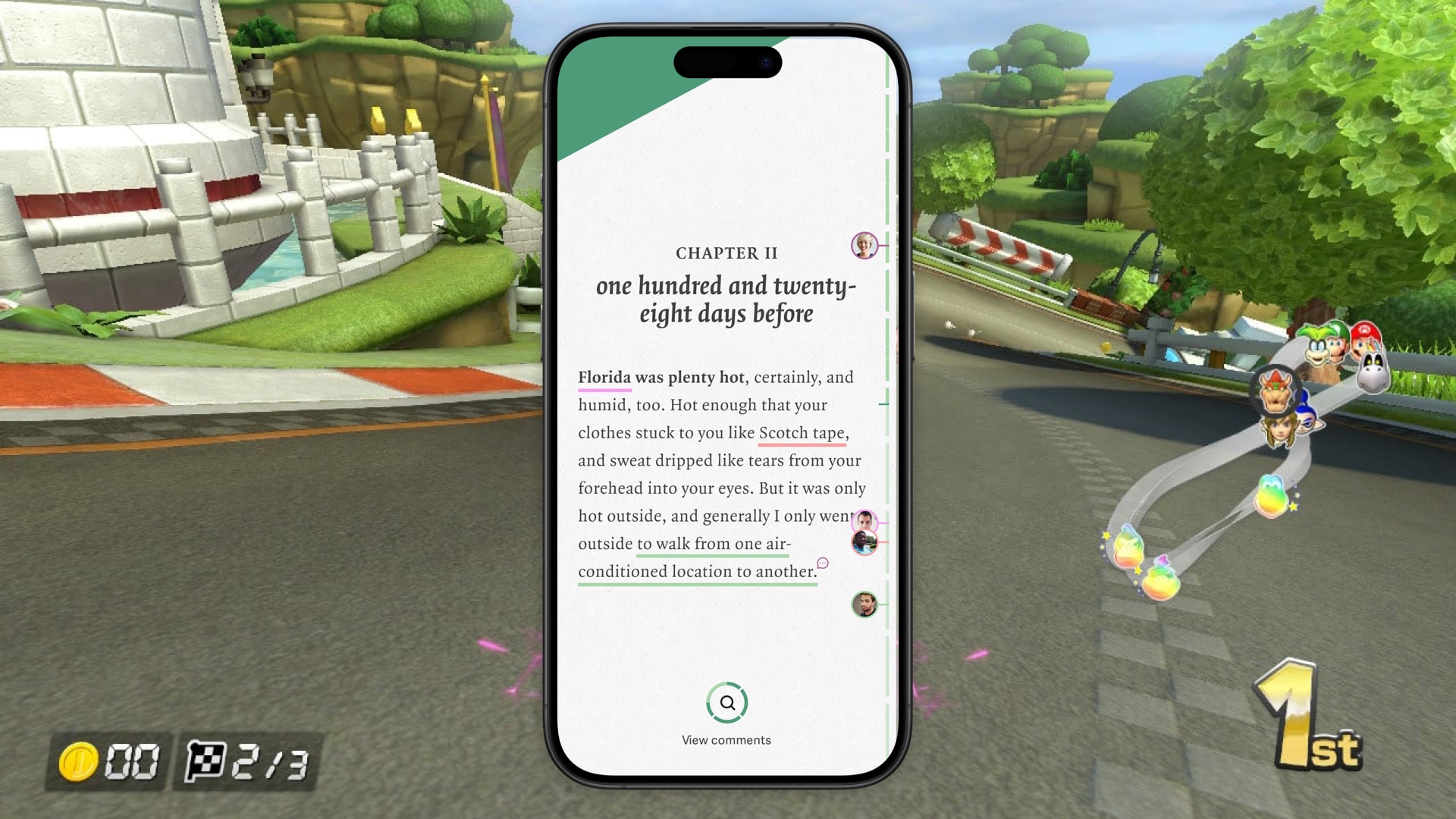
In this post, Immer co-founder Niels ’t Hooft explores the concept of digital social reading and the various ways it could work (and does! or has!), how we’ve built it into the Immer Reading System and how we’ve applied it to VPRO’s Club Lees.
Social reading is as old as the book itself, an inherently social object as it enables passing detailed stories and information between people, crossing time and space.
In Book Was There (2012), Andrew Piper framed the appeal of social reading within the concepts of commonality, transferability and sociability: “We want other people to read the same thing we are reading (commonality); we want to be able to send other people what we are reading (transferability); and we want to be able to talk to other people about what we are reading (sociability).”
Hence book clubs. Hence parents reading the favorite books from their youth to their children. Hence inspirational literary quotes on social media. Hence scribbles in the margins of library books made by previous borrowers.
Immer was founded 4 years ago after a decade-long quest exploring the potential futures of digital reading. I looked at the possibilities of technology, earlier attempts to innovate in the field, and the biggest pain points and desires of readers (and authors and publishers). During this research, social reading was one of those topics that just kept popping up.
What if book clubs could form with members spread around the world, not just posting reviews and discussing them like on Goodreads, but actually honing in on specific sentences or paragraphs together, in the margins of the page?
What if the aforementioned socio-archeological curiosities in library books would not diminish their value, but increase it, by making them optionally visible instead of destructive? Allowing them to go on as long as needed, far beyond the pages’ margins?
What if teachers could ask students to go to their location in a book by tapping on their avatar, mark bits for discussion, and continue the conversation after class?
Researching social reading
One of the most interesting conversations I had when diving deeper into the possibilities of social reading was with Bob Stein.

Bob is a pioneer of digital reading. For example with his Voyager CD-ROMs, he created enriched e-books before they were even called that. In Voyager’s The Society of Mind production (1994), professor Marvin Minsky walked onto the screen at the end of a chapter.
Another pioneering project founded by Bob was SocialBook, 15 years ago, in which readers could mark text and then discuss that marking. It was built on top of Facebook when that was a thing.
In 2015, Bob wrote:
I take heart from the experience of three high school students who after two years of doing all their Spanish literature reading in SocialBook begged their teacher to stay on for one more class instead of retiring, so they could read Don Quijote together. Six thousand comments later they summed it up this way. “It’s been a self-compounding learning process where we constantly inspire each other’s insights.” And, “working in the margins of SocialBook we have discussions on far more topics and in far greater depth than a paper-based approach would allow.”
There also was a somewhat surprising side-effect of social reading, Bob told me. People were having so much fun and learning so much in these ‘marginal’ chats, they were taking much longer to finish their books. This scared off publishers. As you can see in the screenshot above, SocialBook gave almost half the screen to social reading, so it’s not strange that this feature got a lot of the readers’ attention (and attention, or time, can only be spent once).
Looking at examples beyond SocialBook (think of Wattpad, Subtext, Peek, Pigeonhole, Glose and even Kindle), my conclusion was that social reading is not just about the technology that allows you to share notes with anyone. It’s also about the many choices you can make in how, when and where to offer these features. Social reading is a set of design decisions about the experience you want your readers to have.

A very different example is the Dutch organization Culturele Apotheek (‘Cultural Apothecary’). They offer workshops where participants (often elderly people, but not always) read and discuss literary fragments together (often in a live setting, but sometimes online too).
The organizers fully embrace the idea that by minimizing reading, discussion (and social interaction) can be maximized. This makes the barrier to entry much lower, as you don’t have to prepare by reading whole books, while the results are still valuable: deeply emotional, philosophical and/or artistic conversation you would otherwise not have, with people you would otherwise not meet. And after they’ve had a tantalizing taste of a book, participants can still decide to then read it in its entirety.
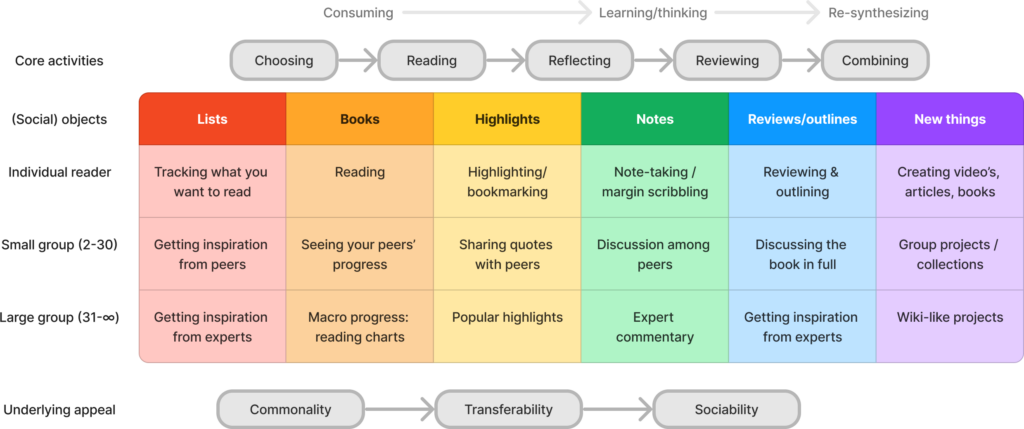
Trying to collect my thoughts on what’s going on in social reading, I came up with the above chart. Horizontally mapped are the different reading activities and (social) objects they lead to, like the lists on Goodreads or popular highlights on Kindle. Vertically mapped are the amount of readers who do it: individuals, small groups (from reading with a friend to book club or classroom size) and large groups (from ’communities of interest’ around a genre, author, topic or different organizing principle, or simply ‘all readers on a platform’, in other words reading together at a scale of 100’s or 1000’s of readers). Hope it’s useful!
If you want to dive deeper into social reading, Federico Pianzola wrote an excellent academic book about it, which is available online for free. Another excellent resource is this 2018 Medium post by Travis Alber, which includes a comprehensive overview of the aforementioned social reading examples and many more.
A Dutch social reading app for young adults
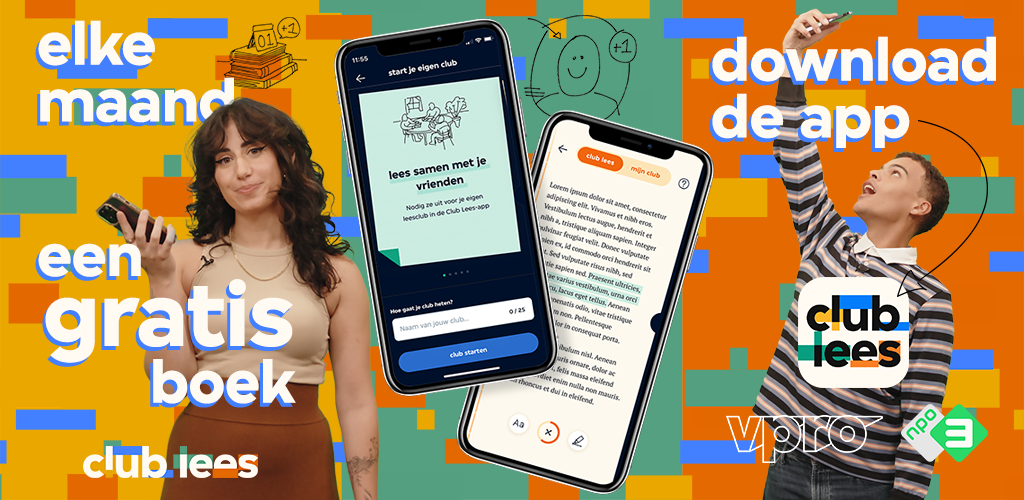
Last summer, we finally got the chance to build upon the above insights when Dutch public broadcasting organization VPRO approached us with their Club Lees (’Club Read’) concept. They’d learned from Brommer op Zee, a TV show about books and companion reading app aimed at a more traditional reading audience. Building on that, they now wanted to create a social reading app for young adults.
Our Immer Reading System was getting to the point where we could use it to power customer applications, and so we decided to build one together. A great occasion to also deploy the group reading feature we’d been planning.
The concept of Club Lees is that 4 young and famous influencer-like personalities choose a book each month. They are currently a singer, a booktoker, an actor and a filmmaker/poet, who are all societally engaged, have big social media followings (helping onboard readers onto Club Lees) and care deeply about reading.
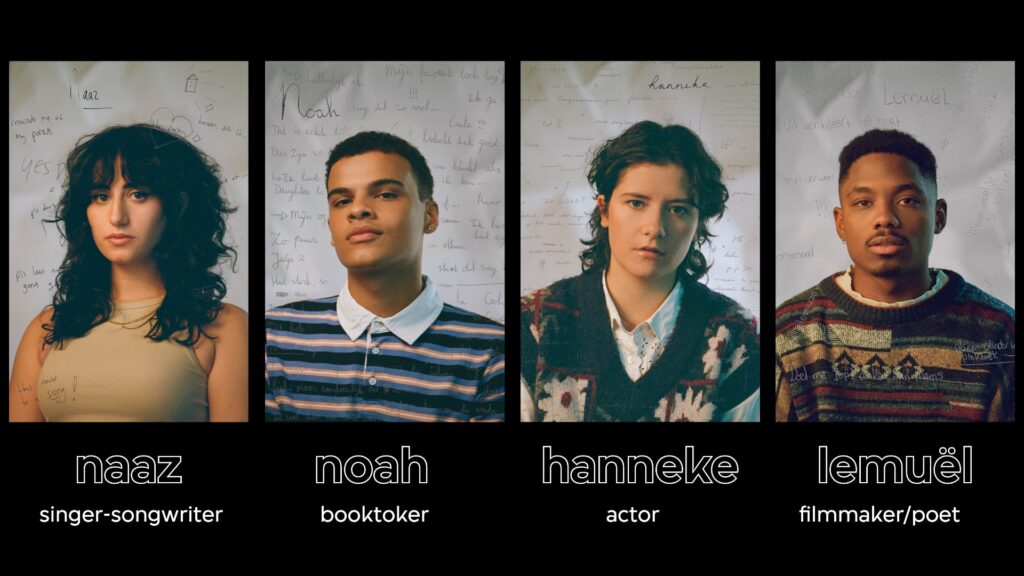
The chosen books are licensed for a month by VPRO, so they can be made available to all Dutch readers for free. This means they’re usually not the newest titles, but they’re eclectic and interesting, the choices are heartfelt, and because the app has a stable and growing readership many people in the audience are gently nudged to read outside of their usual interest bubbles.
The 4 ‘club members’ then fill each book with their annotations, which can be text but also links, audio clips, or video clips. For example this month Hanneke chose Banana Yoshimoto’s 1988 novel Kitchen, which was recently re-translated and re-released in The Netherlands. As part of her annotations, Hanneke interviewed the book’s Dutch translator about Japanese culture and language, of which (video) fragments are scattered throughout the book. It really adds a layer to a book I’d been meaning to read for years.
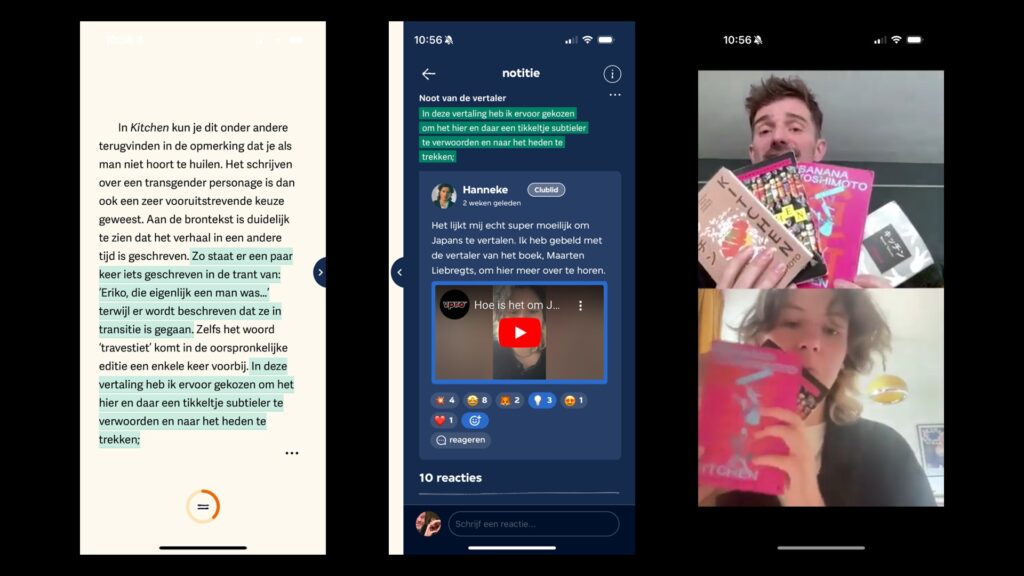
Not only do the notes add a valuable ‘multimedia’ layer to the book, they also give an insight into the 4 club members’ perspectives, and as such these people become like guides for your reading experience. They point out beautiful and interesting things, or encourage you to keep up your reading. Like I said, they really care about these books and that helps propel you through the prose.
What’s more, because the club members respond to each other’s annotations too, they are also guides for talking about the books. Because as a reader, you are free to respond to the notes as well, by typing a comment or reacting with an emoji.
Finally, if you don’t want to be too publicly visible, which was a concern of many users of the earlier Brommer op Zee app, you can even start a private club and invite your friends. Now you can start making your own markings and notes, and chat about them like no-one’s watching.
What the technical setup looks like
Like everything else we do at Immer, Club Lees is built on top of our Immer Reading System. A holistic setup that makes features like the above much easier to implement for a customer like VPRO, who developed the app together with design and innovation agency Norday.
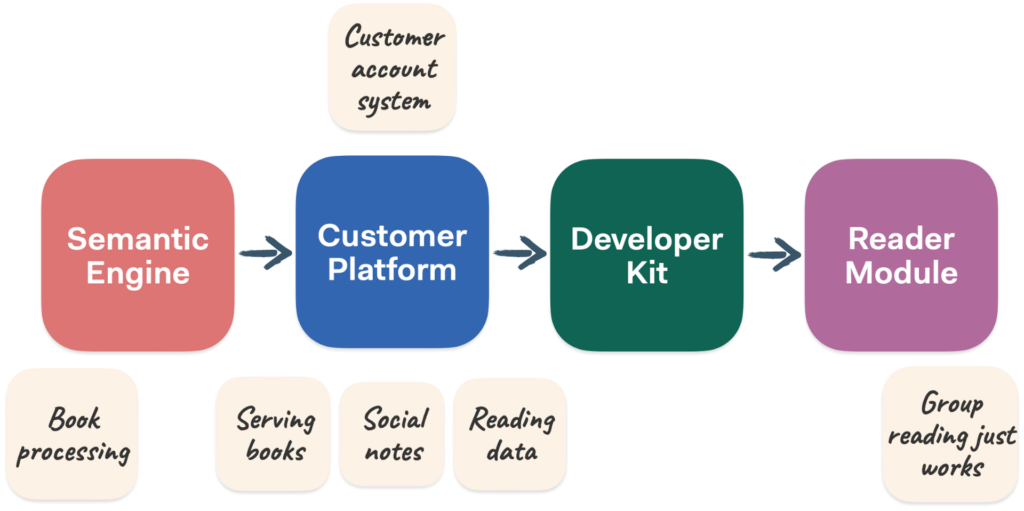
The Immer Reading System takes the publishers’ e-books each month, and pre-processes them to be able to divide them into easy-to-read portions and have stable book positions for all the notes. It then sends those books to the readers in a secure and fast way, synchronizes markings and discussions, and also collects anonymized reading data. We also provide a moderation tool which, even though readers are generally speaking lovely people, will surely prove necessary someday. On the reader’s end, social reading now simply works.
Quick note about privacy: VPRO connected our setup to their own account system, so readers can log in with their (free) VPRO accounts, and we can collect information about their reading behavior (reading speed, types of interaction, book progress, etc.) without ever knowing who each individual reader is, let alone having access to any of their personally identifiable information.
Results so far
In short, Club Lees proves that social reading is a key way to make digital reading more attractive, engaging and retaining.

The potential downside of ‘more talking, less reading’ is offset by VPRO’s smart format of one book each month, which focuses all attention on a unique reading experience. The built-in ephemerality amplifies this even more: like a literary SnapChat, each book and all its activity is gone after the month; even the monthly Zoom meetup is not recorded. (Compare and contrast this setup to Bob Stein’s framework which also talks about ephemerality.)
Overall Club Lees’ readers seem loyal and the ‘end of book’ closing annotation is usually a busy (and insightful) hotspot of social activity. Retention for the project is high, and we’re seeing up to 12% of weekly readers interacting by responding or creating their own notes. More than 5 million text portions have been read so far, and we crossed the milestone of 600 private reading clubs.
We’re happy with these early results and the Club Lees project was recently extended until the end of 2025.
What’s next for social reading
We’re continually improving the Immer Reading System to be more performant, more flexible, and offer more features out of the box. Building on the system, Club Lees recently adopted the new version of our non-linear book browsing feature, and they used the latest version of our SDK to launch a much-requested dark mode.
On the social reading side, we still have many ambitions left for our future roadmap. Especially for small groups, we’d love to show your peers’ book position like in a Mario Kart mini-map. For big groups with many annotations, we’re designing smarter ways to deal with screens overrun with highlights. And that’s lifting the curtain just a tiny bit!
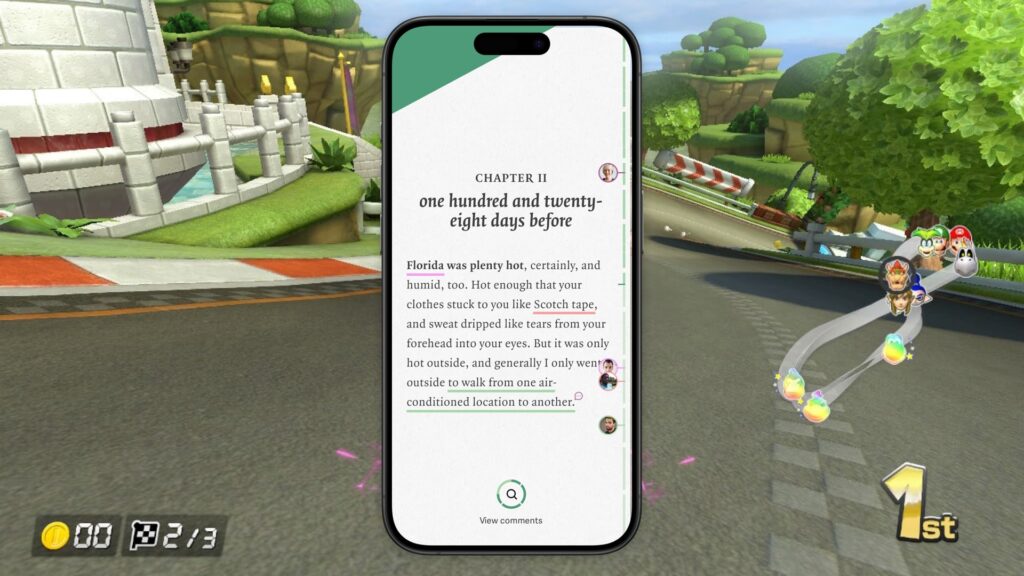
If you’re interested in using these and other features in your new or existing reading app, get in touch. We’re eager to hear your perspective and insights, and would love to see how we can help.
Niels ’t Hooft
Co-founder & CEO Immer